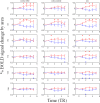Microsaccade rate varies with subjective visibility during motion-induced blindness
- PMID: 19357789
- PMCID: PMC2664481
- DOI: 10.1371/journal.pone.0005163
Microsaccade rate varies with subjective visibility during motion-induced blindness
Abstract
Motion-induced blindness (MIB) occurs when a dot embedded in a motion field subjectively vanishes. Here we report the first psychophysical data concerning effects of microsaccade/eyeblink rate upon perceptual switches during MIB. We find that the rate of microsaccades/eyeblink rises before and after perceptual transitions from not seeing to seeing the dot, and decreases before perceptual transitions from seeing it to not seeing it. In addition, event-related fMRI data reveal that, when a dot subjectively reappears during MIB, the blood oxygen-level dependent (BOLD) signal increases in V1v and V2v and decreases in contralateral hMT+. These BOLD signal changes observed upon perceptual state changes in MIB could be driven by the change of perceptual states and/or a confounding factor, such as the microsaccade/eyeblink rate.
Conflict of interest statement
Figures






Similar articles
-
Motion-induced blindness and microsaccades: cause and effect.J Vis. 2010 Dec 20;10(14):22. doi: 10.1167/10.14.22. J Vis. 2010. PMID: 21172899 Free PMC article.
-
BOLD signal in both ipsilateral and contralateral retinotopic cortex modulates with perceptual fading.PLoS One. 2010 Mar 11;5(3):e9638. doi: 10.1371/journal.pone.0009638. PLoS One. 2010. PMID: 20300177 Free PMC article.
-
Microsaccade directions do not predict directionality of illusory brightness changes of overlapping transparent surfaces.Vision Res. 2006 Oct;46(22):3823-30. doi: 10.1016/j.visres.2006.05.007. Epub 2006 Aug 24. Vision Res. 2006. Corrected and republished in: Vision Res. 2009 Mar;49(7):790.e1-7. doi: 10.1016/j.visres.2008.08.017. PMID: 16934310 Corrected and republished.
-
Changes in visual perception at the time of saccades.Trends Neurosci. 2001 Feb;24(2):113-21. doi: 10.1016/s0166-2236(00)01685-4. Trends Neurosci. 2001. PMID: 11164942 Review.
-
1-D Vision: Encoding of Eye Movements by Simple Receptive Fields.Perception. 2015;44(8-9):986-94. doi: 10.1177/0301006615594946. Perception. 2015. PMID: 26562913 Review.
Cited by
-
Oscillatory modulations in human fusiform cortex during motion-induced blindness: intracranial recording.Clin Neurophysiol. 2012 Oct;123(10):1925-30. doi: 10.1016/j.clinph.2012.02.085. Epub 2012 Apr 12. Clin Neurophysiol. 2012. PMID: 22503904 Free PMC article.
-
Building a decoder of perceptual decisions from microsaccades and pupil size.Front Psychol. 2022 Sep 13;13:942859. doi: 10.3389/fpsyg.2022.942859. eCollection 2022. Front Psychol. 2022. PMID: 36176801 Free PMC article.
-
The effects of fixation target size and luminance on microsaccades and square-wave jerks.PeerJ. 2013 Feb 12;1:e9. doi: 10.7717/peerj.9. Print 2013. PeerJ. 2013. PMID: 23638403 Free PMC article.
-
Simulated forward and backward self motion, based on realistic parameters, causes motion induced blindness.Sci Rep. 2017 Aug 29;7(1):9767. doi: 10.1038/s41598-017-09424-6. Sci Rep. 2017. PMID: 28851914 Free PMC article.
-
Attentional shifts bias microsaccade direction but do not cause new microsaccades.Commun Psychol. 2024 Oct 22;2(1):97. doi: 10.1038/s44271-024-00149-7. Commun Psychol. 2024. PMID: 39438653 Free PMC article.
References
-
- Bonneh YS, Cooperman A, Sagi D. Motion-induced blindness in normal observers. Nature. 2001;14:798–801. - PubMed
-
- Graf EW, Adams WJ, Lages M. Modulating motion-induced blindness with depth ordering and surface completion. Vision Res. 2002;42:2731–2735. - PubMed
-
- Hsu LC, Yeh SL, Kramer P. Linking motion-induced blindness to perceptual filling-in. Vision Res. 2004;44:2857–2866. - PubMed
-
- Troxler D. Über das Verschwinden gegebener Gegenstände innerhalb unsers Gesichtskreises, In: Himly K, Schmidt JA, editors. Ophthalmologisches Bibliothek. Jena: Fromman; 1804. pp. 51–53.
-
- Ramachanndran V. Blindspot. Sci Am. 1992;266:4–49.
Publication types
MeSH terms
Grants and funding
LinkOut - more resources
Full Text Sources

